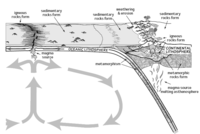Biogeochemical cycle

Okay, imagine that you are playing with some toys in your room. You have a big toy box where you keep all your toys. You take some toys out to play with them, but when you are done, you put them back in the toy box, right?
Now let's think about the Earth. It is like a huge toy box filled with living things, like plants, animals, and all kinds of microscopic organisms. These living things are made up of different elements like oxygen, carbon, nitrogen, and phosphorus.
Just like how you put your toys back in the toy box, these elements are constantly moving and cycling through the Earth's system. This is called a biogeochemical cycle.
Let's take carbon, for example. It is an important element for life on Earth. Plants take in carbon dioxide from the air during photosynthesis, and they use it to make their own food. Animals then eat the plants and take in the carbon. When the animals breathe out or excrete waste, they release carbon back into the air or soil.
This is just one example of how elements cycle through the Earth's system. The biogeochemical cycle is a way of explaining how these elements move and change over time in a natural balance.
So, in essence, the biogeochemical cycle is like a big toy box that is constantly moving and recycling toys (or elements in this case) to support the life on Earth.
Now let's think about the Earth. It is like a huge toy box filled with living things, like plants, animals, and all kinds of microscopic organisms. These living things are made up of different elements like oxygen, carbon, nitrogen, and phosphorus.
Just like how you put your toys back in the toy box, these elements are constantly moving and cycling through the Earth's system. This is called a biogeochemical cycle.
Let's take carbon, for example. It is an important element for life on Earth. Plants take in carbon dioxide from the air during photosynthesis, and they use it to make their own food. Animals then eat the plants and take in the carbon. When the animals breathe out or excrete waste, they release carbon back into the air or soil.
This is just one example of how elements cycle through the Earth's system. The biogeochemical cycle is a way of explaining how these elements move and change over time in a natural balance.
So, in essence, the biogeochemical cycle is like a big toy box that is constantly moving and recycling toys (or elements in this case) to support the life on Earth.
Related topics others have asked about:
